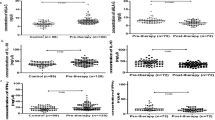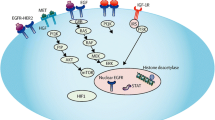Abstract
Identifying serum pre-treatment molecular markers that can predict response to therapy is of great interest in head and neck oncology and is required to develop personalized treatments that maximize survival while minimizing morbidity. The main aim was to investigate the potential prognostic significance of tumor necrosis factor-like weak inducer of apoptosis (TWEAK), and its receptors, fibroblast growth factor-inducible 14 (Fn14) and CD163, in head and neck squamous cell carcinoma (HNSCC). The study comprised 37 consecutive patients with pathologically confirmed, untreated HNSCC. Serum and tissue samples from these patients were available for study. We determined sTWEAK and sCD163 levels in serum from 37 HNSCC patients by ELISA. TWEAK, CD163, Fn14 and TNF-α gene expression were detected by real-time RT-PCR in 111 matched tissue samples (tumoral, adjacent and distal/normal mucosa). Our results showed a significant relationship between low sTWEAK levels and poor locoregional control of the disease. Kaplan–Meier curves indicated that the locoregional recurrence-free survival rate in patients with low sTWEAK circulating levels was significantly lower than in patients with high levels, and that high CD136/TWEAK expression ratio in tumors was also related to poor prognosis. sTWEAK pre-treatment serum levels might be used as prognostic non-invasive biomarkers for locoregional control in patients with HNSCC. Future investigations are warranted to determine the potential prognostic significance of this non-invasive biomarker in the rapid discrimination according to the locoregional control achieved in patients who received a non-surgical organ preservation treatment.



Similar content being viewed by others
References
Quintana A, Avilés FX, Terra X et al (2013) Overexpression of the nuclear factor-kappa B (p65) in association with local failure in patients with head and neck carcinoma undergoing radiotherapy or chemoradiotherapy. Head Neck 35:370–375
Jackson-Bernitsas D, Ichikawa H, Takada Y et al (2006) Evidence that TNF-TNFR1-TRADD-TRAF2-RIP-TAK1-IKK pathway mediates constitutive NF-kB activation and proliferation in human head and neck squamous cell carcinoma. Oncogene 26:1385–1397
Duffey DC, Crowl-Bancroft C, Chen Z et al (2000) Inhibition of transcription factor nuclear factor-kB by a mutant inhibitor-kB attenuates resistance of human head and neck squamous cell carcinoma to TNF-a caspase-mediated cell death. Br J Cancer 83:1367–1374
Winkles JA (2008) The TWEAK-Fn14 cytokine-receptor axis: discovery, biology and therapeutic targeting. Nat Rev Drug Discov 7:411–425
Llauradó G, González-Clemente JM, Maymó-Masip E, Subías D, Vendrell J, Chacón MR (2012) Serum levels of TWEAK and scavenger receptor CD163 in type 1 diabetes mellitus: relationship with cardiovascular risk factors. A Case-Control Study. PLoS One 7:e43919
Burkly LC, Michaelson JS, Zheng TS (2011) TWEAK/Fn14 pathway: an immunological switch for shaping tissue responses. Immunol Rev 244:99–114
Tang X (2013) Tumor-associated macrophages as potential diagnostic and prognostic biomarkers in breast cancer. Cancer Lett 332:3–10
Polek TC, Talpaz M, Darnay BG, Spivak-Kroizman T (2003) TWEAK mediates signal transduction and differentiation of RAW264.7 cells in the absence of Fn14/TweakR: evidence for a second TWEAK receptor. J Biol Chem 278:32317–32323
Bover LC, Cardó-Vila M, Kuniyasu A et al (2007) A previously unrecognized protein–protein interaction between TWEAK and CD163: potential biological implications. J Immunol 178:8183–8194
Dai L, Gu L, Ding C, Qiu L, Di W (2009) TWEAK promotes ovarian cancer cell metastasis via NF-kB pathway activation and VEGF expression. Cancer Lett 283:159–167
Gaudineau B, Fougère M, Guaddachi F, Lemoine F, de la Grange P, Jauliac S (2012) Lipocalin 2, the TNF-like receptor TWEAKR and its ligand TWEAK act downstream of NFAT1 to regulate breast cancer cell invasion. J Cell Sci 125:4475–4486
Willis AL, Tran NL, Chatigny JM et al (2008) The fibroblast growth factor-inducible 14 receptor is highly expressed in HER2-positive breast tumors and regulates breast cancer cell invasive capacity. Mol Cancer Res 6:725–734
Kwon O, Park S, Kang T et al (2012) Elevated fibroblast growth factor-inducible 14 expression promotes gastric cancer growth via nuclear factor-κB and is associated with poor patient outcome. Cancer Lett 314:73–81
Michaelson JS, Kelly R, Yang L, Zhang X, Wortham K, Joseph IBJK (2012) The anti-Fn14 antibody BIIB036 inhibits tumor growth in xenografts and patient derived primary tumor models and enhances efficacy of chemotherapeutic agents in multiple xenograft models. Cancer Biol Ther 13:812–821
Nakayama M, Ishidoh K, Kayagaki N et al (2002) Multiple pathways of TWEAK-induced cell death. J Immunol 168:734–743
Zou H, Wang D, Gan X et al (2011) Low TWEAK expression is correlated to the progression of squamous cervical carcinoma. Gynecol Oncol 123:123–128
Wang D, Fung JNT, Tuo Y, Hu L, Chen C (2010) TWEAK/Fn14 promotes apoptosis of human endometrial cancer cells via caspase pathway. Cancer Lett 294:91–100
Kaduka Y, Takeda K, Nakayama M, Kinoshita K, Yagita H, Okumura K (2005) TWEAK mediates anti-tumor effect of tumor-infiltrating macrophage. Biochem Biophys Res Commun 331:384–390
Chiesa F, Mauri S, Tradati N et al (1999) Surfing prognostic factors in head and neck cancer at the millennium. Oral Oncol 35:590–596
Varilla V, Atienza J, Dasanu CA (2013) Immune alterations and immunotherapy prospects in head and neck cancer. Expert Opin Biol Ther 13:1241–1256
Douglas WG, Tracy E, Tan D et al (2004) Development of head and neck squamous cell carcinoma is associated with altered cytokine responsiveness. Mol Cancer Res 2:585–593
Wang S, Zhan M, Yin J et al (2006) Transcriptional profiling suggests that Barrett’s metaplasia is an early intermediate stage in esophageal adenocarcinogenesis. Oncogene 25:3346–3356
Jakubowski A, Ambrose C, Parr M et al (2005) TWEAK induces liver progenitor cell proliferation. J Clin Invest 115:2330–2340
Gu L, Dai L, Cao C et al (2013) Functional expression of TWEAK and the receptor Fn14 in human malignant ovarian tumors: possible implication for ovarian tumor intervention. PLoS ONE 8:e57436
Tran NL, McDonough WS, Donohue PJ et al (2003) The human Fn14 receptor gene is up-regulated in migrating glioma cells in vitro and overexpressed in advanced glial tumors. Am J Pathol 162:1313–1321
Kawakita T, Shiraki K, Yamanaka Y et al (2004) Functional expression of TWEAK in human hepatocellular carcinoma: possible implication in cell proliferation and tumor angiogenesis. Biochem Biophys Res Commun 318:726–733
Ho DH, Vu H, Brown SAN, Donohue PJ, Hanscom HN, Winkles JA (2004) Soluble tumor necrosis factor-like weak inducer of apoptosis overexpression in HEK293 cells promotes tumor growth and angiogenesis in athymic nude mice. Cancer Res 64:8968–8972
Schneider P, Schwenzer R, Haas E et al (1999) TWEAK can induce cell death via endogenous TNF and TNF receptor 1. Eur J Immunol 29:1785–1792
Sabour Alaoui S, Dessirier V, de Araujo E et al (2012) TWEAK affects keratinocyte G2/M Growth arrest and induces apoptosis through the translocation of the AIF protein to the nucleus. PLoS ONE 7:e33609
Zhou H, Hittelman WN, Yagita H et al (2013) Antitumor activity of a humanized, bivalent immunotoxin targeting Fn14-positive solid tumors. Cancer Res 73:4439–4450
Urbonaviciene G, Martin-Ventura JL, Lindholt JS, Urbonavicius S, Moreno JA, Egido J, Blanco-Colio LM (2011) Impact of soluble TWEAK and CD163/TWEAK ratio on long-term cardiovascular mortality in patients with peripheral arterial disease. Atherosclerosis 219:892–899
Jelic-Ivanovic Z, Bujisic N, Spasic S et al (2009) Circulating sTWEAK improves the prediction of coronary artery disease. Clin Biochem 42:1381–1386
Moreno JA, Dejouvencel T, Labreuche J et al (2010) Peripheral artery disease is associated with a high CD163/TWEAK plasma ratio. Arterioscler Thromb Vasc Biol 30:1253–1262
Kralisch S, Ziegelmeier M, Bachmann A et al (2008) Serum levels of the atherosclerosis biomarker sTWEAK are decreased in type 2 diabetes and end-stage renal disease. Atherosclerosis 199:440–444
Acknowledgments
This study was supported by the Institut d’Investigació Sanitària Pere Virgili, Tarragona, Catalonia (IISPV) and by the Instituto de Salud Carlos III, Ministerio de Economia y Competitividad, Spain (Grant Numbers PI11/00049 to MRCH, PI11/00085 to JV and PI11/02380 to XL). MRCH is supported by the Research Stabilization Programme of the Instituto de Salud Carlos III (ISCIII) co-financed by Institut Català de Salut (ICS) in Catalonia, Spain. We express our gratitude to Meritxell Cortés and Jessica Capera for their assistance in sample collection.
Conflict of interest
None.
Author information
Authors and Affiliations
Corresponding authors
Additional information
Francesc Xavier Avilés-Jurado and Ximena Terra have contributed equally to this work.
Rights and permissions
About this article
Cite this article
Avilés-Jurado, F.X., Terra, X., Gómez, D. et al. Low blood levels of sTWEAK are related to locoregional failure in head and neck cancer. Eur Arch Otorhinolaryngol 272, 1733–1741 (2015). https://doi.org/10.1007/s00405-014-3095-2
Received:
Accepted:
Published:
Issue Date:
DOI: https://doi.org/10.1007/s00405-014-3095-2




